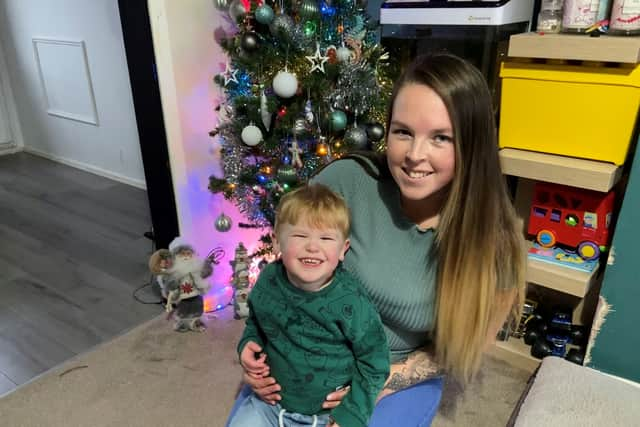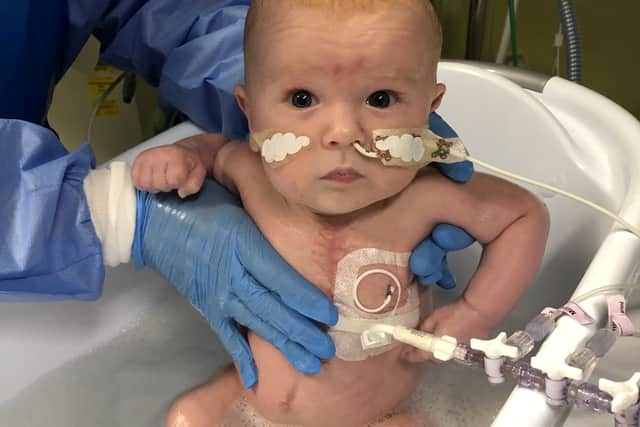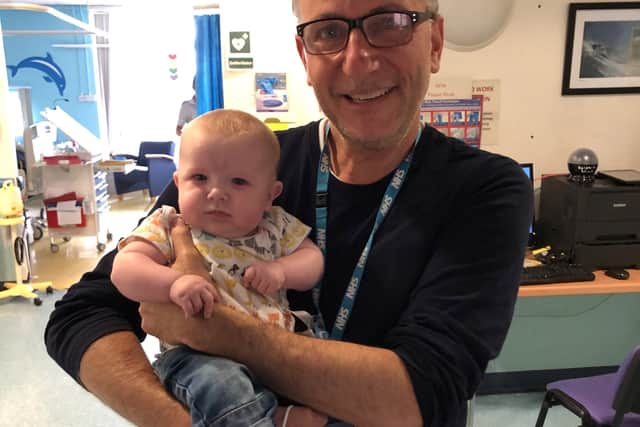‘World-first’ operation takes place in Bristol hospital to cure baby’s heart defect
and live on Freeview channel 276
A heart surgeon has carried out a ‘world-first’ operation using stem cells from placentas to cure a baby’s heart defect. Professor Massimo Caputo from the Bristol Heart Institute used pioneering stem cell injections to correct a two-month-old’s heart disease, which ‘probably saved the life’ of the boy.
The recipient of the life-saving procedure, Finley, is now two years old and ‘a happy growing little boy’. He was born with the main arteries in his heart the wrong way round and at just four years old had his first open-heart surgery at Bristol Royal Hospital for Children.
Advertisement
Hide AdAdvertisement
Hide AdUnfortunately, Finley’s heart function continued to deteriorate significantly, and his parents were told to expect the worst and that the doctor’s had ‘done everything they could’.
His mother Melissa said: “Everything happened so quickly after giving birth. It was such a shock to find out that Finley had a heart condition and that he needed open-heart surgery.
“When he was born, I was only able to hold his hand for seconds through the incubator before he was whisked away to the ambulance.
We nearly lost Finley when he was just 2 months old. Doctors called us into a room and told us they’d done everything they could. That’s when Massimo came to find us and explained there was one option left – to inject stem cells into the left side of Finley’s heart.
Advertisement
Hide AdAdvertisement
Hide Ad“He warned us that he couldn’t predict what the outcome would be. But we had absolutely nothing to lose. We had to try and give Finley every possible chance to live.”


Professor Caputo used donor stem cells to inject directly into Finley’s heart during a second surgical procedure, in the hope they would help damaged blood vessels grow to increase the blood supply to the left side of his heart - which was suffering from a severe lack of blood flow.
Currently many children with heart anomalies are given open-heart surgery to temporarily repair the problem, but as the materials used are not completely biological they cannot grow with the baby and can be rejected.
Professor Caputo’s stem cell plasters are designed to be sewn into the area of the child’s heart that needs repairing during surgery. The stem cells could then boost the repair of heart tissue without being rejected by the child’s body. These patches have the potential to adapt and grow with the child’s heart as they get older, removing the need for repetitive heart surgeries and the many days at hospital recovering after each one.


Advertisement
Hide AdAdvertisement
Hide AdMellissa continued: “Within two weeks of the stem cell treatment we noticed a change in Finley. He came home for the first time when he was just 6 months old on a machine that still helps him breathe at night.
“We can’t thank Massimo enough. I believe, if it wasn’t for the stem cell treatment, then Finley wouldn’t be here with us today. Finley is very feisty and very funny – he’s a real heart warrior and I tell him that all the time.
“We don’t know what the future brings, but we are so grateful for Finley’s life to be turned around after the stem cell treatment as he now has a chance at life he might not have had otherwise.”
Massimo Caputo, BHF Professor of Congenital Heart Surgery at the Bristol Heart Institute, University of Bristol, said: “For years families have come to us asking why their child needs to have heart surgery time and time again.


Advertisement
Hide AdAdvertisement
Hide Ad“Although each operation can be lifesaving, the experience can put an unbelievable amount of stress on the child and their parents. We believe that our stem cell patches will be the answer to solve these problems.
“Our ultimate vision in the next decade is to create a paradigm shift in the way doctors treat congenital heart disease, by developing personalised stem cell and genetically-engineered treatments for the most complex of heart defects.”
Dr Sonya Babu-Narayan, Associate Medical Director at the British Heart Foundation, said: “If successful, this new stem cell therapy that acts like a healing plaster could revolutionise the results of heart surgery for children and adults living with congenital heart disease.
“It could offer a solution that means their heart is mended once and forever in a single operation, preventing people from facing a future of repeated surgeries and giving them the gift of a happier and healthier life.”
Comment Guidelines
National World encourages reader discussion on our stories. User feedback, insights and back-and-forth exchanges add a rich layer of context to reporting. Please review our Community Guidelines before commenting.